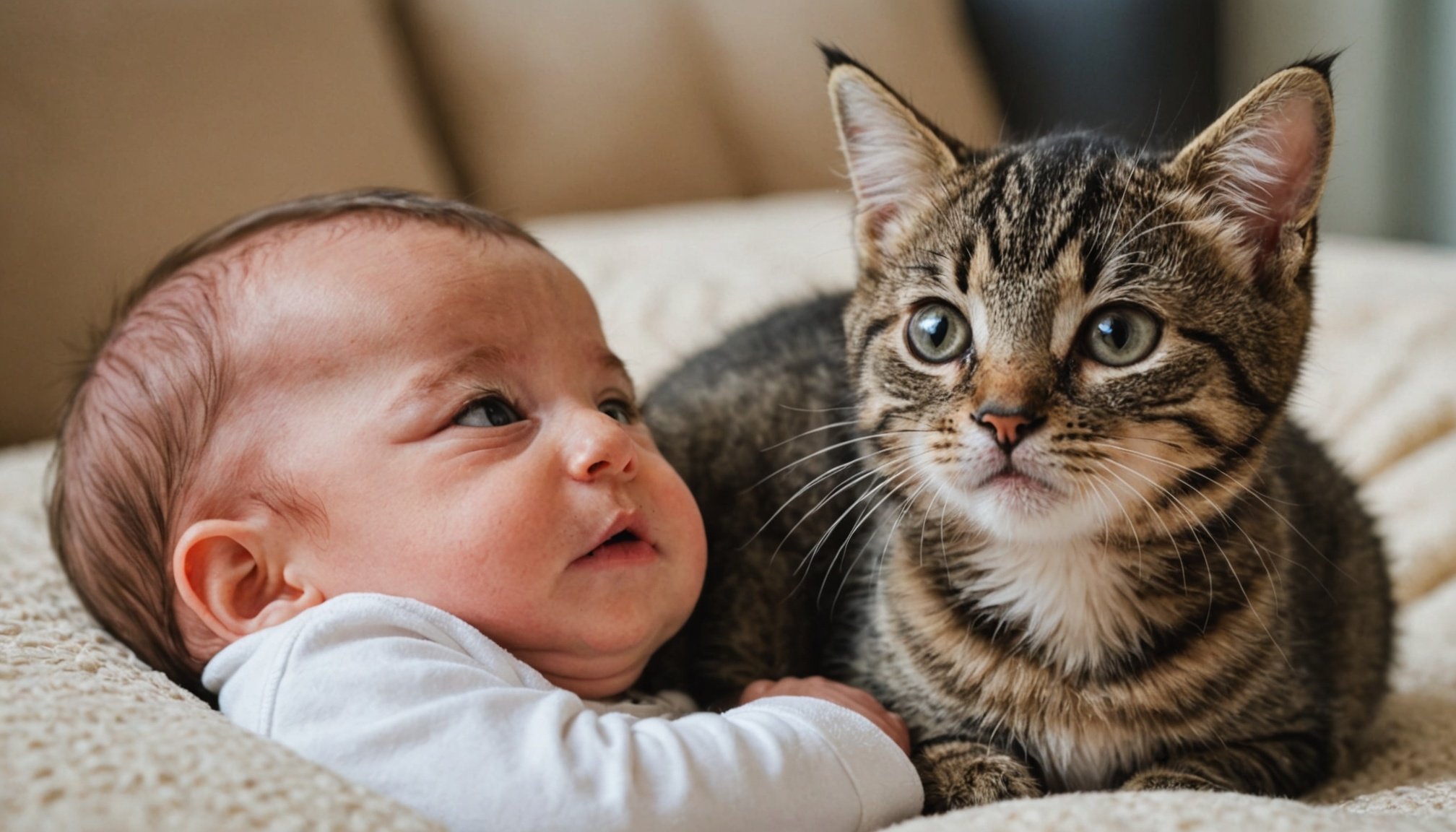Preparing Your Cat for the New Arrival
Bringing a new baby into your home is an exciting time, but it requires careful preparation to ensure a smooth transition for your cat. Here’s how you can help your feline friend adjust their behaviour before the new arrival.
Firstly, establish a safe space exclusively for your cat. This area should be away from the baby’s proposed space, allowing your cat to retreat whenever they feel the need. Equip this space with their favourite bedding and toys, ensuring it is a comforting and familiar environment.
A lire également : Essential Tips for Nurturing Your Feline Friend with Arthritis: Best Practices for Cat Care
Gradually alter your cat’s routine to ease any possible adjustments. Begin by subtly changing feeding and playtimes over a few weeks, so the new rhythm feels natural. This practice helps your cat adapt without sudden shifts in routine when the baby arrives.
To further assist with their behavior adjustment, introduce baby scents and sounds. Playing recordings of baby noises at a low volume may help your cat become accustomed to the new sounds anticipated in their environment. Similarly, using a baby lotion or powder on a soft cloth can allow them to sniff and become familiar with the baby’s scent. With preparation, your cat can comfortably adapt to the growing family.
A lire également : Spotting Heat Exhaustion in Cats: Effective Prevention Tips for Pet Owners
Understanding Your Cat’s Behavior
Cats communicate through a complex mix of signals and behaviors, making it vital for owners to interpret these correctly to ensure their pets’ well-being. Stress in cats often manifests through signs such as excessive grooming, changes in eating habits, or litter box avoidance. Recognising these signs of stress is crucial in maintaining your cat’s health and happiness.
Understanding cat behavior requires deciphering feline body language. For instance, a softly swishing tail usually indicates curiosity, whereas a rapidly twitching tail can be a sign of irritation. Ears pinned back and dilated pupils typically signify anxiety or fear. Observing these cues can help you adjust your interactions and provide a more reassuring environment.
Behavioral changes are common during transitional phases, like moving homes or introducing a new family member. Early interactions can sometimes trigger unease in cats, and being vigilant about any deviations from their regular habits can highlight potential issues. Monitoring cat communication patterns—like increased vocalisation or withdrawn behavior—can inform you of their comfort levels and help you respond appropriately.
In sum, by understanding and interpreting your cat’s behavior, you can foster a supportive atmosphere that mitigates stress and strengthens the bond between you and your feline companion.
Step-by-Step Introduction Process
Introducing a baby to a cat requires careful planning and patience to ensure a safe and harmonious household. The key to success lies in gradual exposure and implementing appropriate safety measures.
Initial Introduction Protocol
Begin by allowing the cat to become accustomed to the idea of a new presence. Place objects with the baby’s scent, like clothes or blankets, around the house, encouraging the cat to investigate at its own pace. This stage is crucial for creating familiarity before face-to-face interactions occur.
Controlled Meetings
The first actual meeting should be carefully managed. Keep the baby at a distance initially, perhaps in a crib or someone’s arms, while the cat is free to approach if it wishes. This ensures that the encounter remains positive and stress-free for both parties. The duration of these meetings should be kept brief, progressively extending them as both the baby and cat show comfort.
Supervised Interactions
Continue with increased interaction times, always under supervision. Consider using barriers, like baby gates, to foster a calm environment where both the baby and cat can observe each other safely without direct contact. These interactions should also remain positive and involve treats or toys, encouraging a naturally positive association with the new family member.
Creating a Safe Environment for Both
Ensuring both a safe baby environment and maintaining cat comfort involves planning and boundary setting. Begin by making baby areas off-limits to your cat. Not only is this important for your baby’s safety, but it also helps in maintaining a balance between baby and pet needs. Place essential baby items, like cribs and changing tables, in rooms where you can keep doors closed or use baby gates.
Adjust your household to include effective cat safety measures that prevent potential conflicts. Modify your cat’s space by adding more climbing or resting areas that are not accessible to the baby. This separation helps the cat feel secure and establishes a space free from disruptions. It’s crucial to maintain consistency for the cat, so keep their beds, litter boxes, and feeding areas stable.
Utilising baby gates or barriers efficiently can significantly reduce unwanted interactions. Position these gates strategically between rooms or access points to create clear distinctions. Opt for gates high enough that your cat can either comfortably jump over, or secure enough that they decide not to attempt. These adjustments provide safety and comfort for both your child and your beloved pet.
Addressing Common Issues
When dealing with cat challenges, understanding the root cause is key. Jealousy and attention-seeking behaviors can often stem from changes in your household, such as new family members or pets. Behavioral solutions include ensuring your cat feels secure and loved. Provide individual attention and integrate a routine to comfort them.
Handling Litter Box Issues
Stress-induced litter box problems can be frustrating. Cats may avoid their box due to anxiety or discomfort. A simple yet effective problem-solving tip is to maintain a calm environment. Ensure the litter box is in a quiet, accessible location, cleaned regularly, and free of any potential stressors.
Consulting a Veterinarian
Sometimes, these issues require professional intervention. Understanding when to consult a veterinarian for behavioral problems is crucial. Persistent or severe behaviors might point to medical conditions needing attention. Timely intervention can prevent further stress and ensure your feline friend’s well-being.
In addressing these challenges, remember empathy is vital. By staying attentive to your cat’s needs and employing effective solutions, you’re not only resolving issues but also enhancing a harmonious living environment.
Long-term Integration and Monitoring
Fostering a long-term relationship between your baby and cat can be a delightful journey. Encouraging positive interactions as they grow together lays the foundation for baby and cat bonding. By nurturing mutual respect and affection, both the baby and the cat can benefit from each other’s presence. Regular playtime with adult supervision ensures the habitat remains harmonious and engaging for all involved.
Consistent and ongoing supervision is vital in maintaining this bond. Watch for any signs of discomfort or behavior changes in your cat as the baby becomes more active. Cats, by nature, are sensitive to their environment, and sudden changes, like a fast-moving toddler, can induce stress.
Maintain harmony by reinforcing positive behavior. Use rewards and praise to commend your cat when they show patience and gentleness during interactions. This encourages a welcoming attitude towards the baby’s explorative nature.
Here are some points to consider:
- Foster gentle interactions during shared activities.
- Monitor your cat’s body language for signs of stress.
- Continue rewarding your cat with praise to reinforce positive actions.
By attending to these details, you can support a nurturing and safe long-term relationship.











